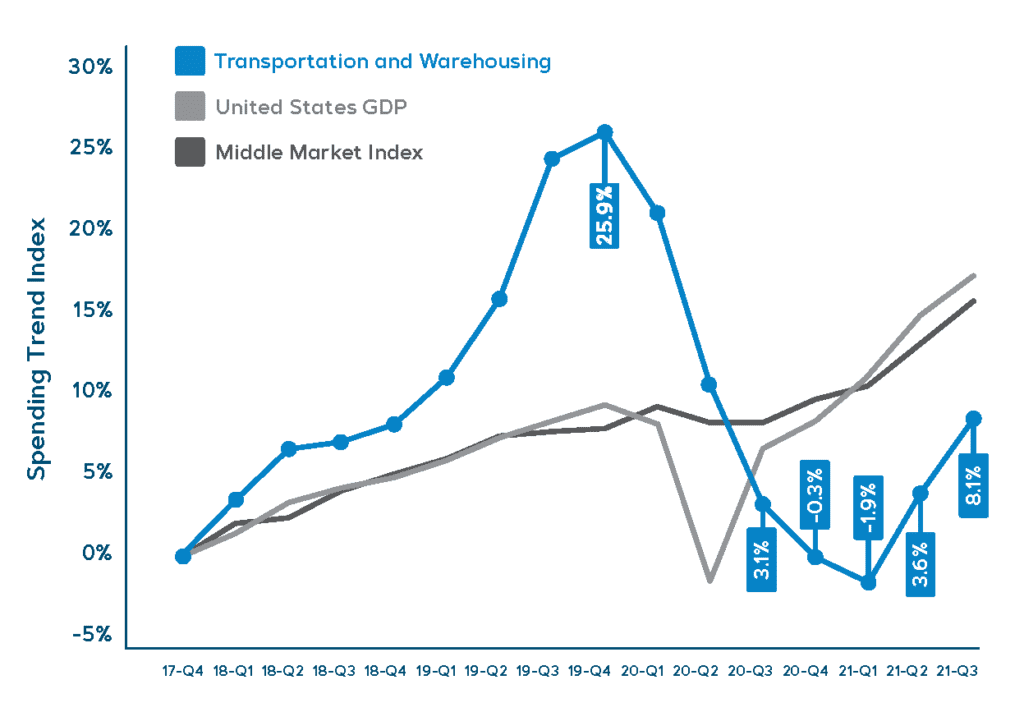While the pandemic changed a number of industries in profound and unprecedented ways, you’d be hard-pressed to find an industry more radically transformed than real estate.
Reconfiguration of the residential and commercial real estate space has been widely covered, but AvidXchange’s AvidIndex, which analyzes millions of payments made across the AvidPay Network each quarter, showed an interesting trend emerging in the industrial warehousing sector.
Industrial warehousing consists of basic warehouse buildings, often located near or within cities, where corporate products and supplies can be conveniently stored and shipped quickly to nearby customers.
Now on to the data:
Spending on transportation and industrial warehousing by middle-market companies in Q3 2021 rose to 8.1 percent above AvidIndex's December 2017 benchmark. That was a measurable 4.5 percentage point rise from Q2 2021.
Source: Middle Market Spending Trends Report, Q3 2021

Spending on the industry is still well below its peak (25.9 percent above benchmark in Q4 2019), but the increase was larger than any of the nine other industries tracked by AvidIndex.
Plenty of other research paints this growth picture. A Jones Lang LaSalle IP, Inc. report reveals the industry hit a historically low vacancy rate of 4.3 percent in Q3 2021. Concurrently, rents bounced up by 7.1 percent.
A report by CBRE Econometric Advisors found nearly 80 percent of U.S. industrial markets will post positive rent growth during the next year, and most will top their historical average through the next several years.
“The industrial warehousing market is booming right now. More new businesses have started up since the pandemic began with rapidly growing needs to store their products in local facilities for faster and easier delivery to customers. That’s driving up demand and rent rates to use these facilities. During the coming months, expect more real estate developers to buy land and build these warehouses to grow their businesses.”
Brian Thayer, Vice President of Sales, AvidXchange
So how big is this market and how fast is it growing? Overall, the warehousing and storage market is expected to grow at 9 percent through 2025 and reach a value of $627.5 billion, according to Business Research Company.
What's driving the increased spend on industrial warehousing?
All these rising numbers beg the question: What’s the story behind this growth story? It’s basic: Demand for these warehouses is outpacing supply, according to CBRE:
“Occupiers are leasing space at unprecedented levels to handle the large increase in inventory requirements given strong consumer demand. The need to keep more ‘safety stock’ onshore amid supply chain volatility has spurred additional demand for warehouse space.”
A major driver behind this market expansion has been the pandemic’s impact on global supply chains, causing product delivery delays and higher transportation costs.
Simply, domestic industrial warehouse space allows businesses faster and less expensive access to store and ship products and supplies.
The impact of e-commerce on industrial warehousing
Since the onset of the pandemic there’s been a surge in ecommerce retailers filling the shopping void for consumers wary about visiting physical locations.
In the first quarter of 2020 (before the pandemic peaked in the U.S.), e-commerce sales in the U.S. totaled approximately $160 billion, according to the U.S. Census Bureau. In Q2 when the pandemic reached its highest levels, e-commerce sales shot up to $211 billion.
While convenient and wise from a health standpoint, enormous online buying flooded global markets with orders for products. Supply chains weren’t ready. Item shortages emerged. The price of domestic transportation surged along with fuel prices. And container shipping costs from China to U.S.’ West Coast ports increased nearly 700 percent, according to a report by Cushman & Wakefield.
Industrial warehousing trends: Opportunities for finance pros
Now armed with contextual understanding of this trend, let’s discuss the opportunities.
Warehouses, at their core, need to operate more efficiently by moving more products faster and more reliably at lower costs. Efficiency is paramount. One way to do this is by using automated technologies which, so far, aren’t used nearly as much as they could be in this market.
Remarkably, according to Research and Markets, 80 percent of warehouses have no automation. And though this report focuses on automating of the physical movement of goods, there’s an opportunity to leverage the power of automation in back-office functions that are critical to a business, like accounts payables.
Here are seven reasons why finance professionals in the industrial warehousing space may benefit from automated accounts payable (AP) and payment technology:
1. Consolidated dashboard for multi-tenant warehouses
Consider this example: A real estate company that has 10 different industrial warehouse properties can tap into automation to consolidate the processing of invoices and payments generated by these facilities into one dashboard database.
By unifying these databases, you create more efficiencies than working with disaggregated paper invoices and payments in each warehouse. Using one dashboard, the property manager could gain more visibility at each warehouse into the status of invoices and payments.
2. Handling growth in invoices and payments
As we pointed out earlier, the pandemic caused more people to buy products online in larger amounts. That, in turn, meant many businesses including warehouses needed to process more invoices and payments. Use of AP automation instead of paper makes it easier for your finance team to process more of these transactions faster with fewer mistakes.
3. Automation helps speed up product deliveries
The need to deliver products to customers faster is a main market driver. AP automation helps you speed up invoice and payments compared with paper processes. Your entire warehousing operation can improve by accelerating product deliveries and minimizing AP paperwork.
4. AP automation reduces manual work
Your finance team will benefit from processing more invoices and payments using automation. They’ll have more time for more fulfilling strategic projects that add more value to your business.
5. Automation lowers security risks
With more invoices and payments needing to be processed in these warehouses, there’s the potential for more cyberattacks — especially if you use paper. Leveraging automation, you’ll lower the chances these cybercriminals can penetrate your invoice and payment processes.
6. Automation helps handle bulk purchasing
Throughout the pandemic people use e-commerce to buy large quantities of products to prepare for the crisis and beyond. This wave of high-volume buying flooded supply chains with orders that couldn’t be efficiently handled.
Automated AP processing helps you control this bulk buying and cut the amount of chaos in the invoicing and processing payments. Instead of having to deal with one piece of paper for every one of these purchases, invoices and payments, AP automation changes that information to digital formats and makes it faster, easier and more reliable to handle.
7. Automation gives you better control of cash
As you run your growing and more complex industrial warehouse business, you’ll find it harder to keep track of how much cash you have on hand to pay vendors and make other purchases – if you use paper.
Using automated AP, it’ll be much easier to find out how much money you have because you’ll more easily figure out when invoices got processed and paid. That means you’ll be able to get your hands on your cash quicker.
Final thoughts
You’re now up to speed on a story to celebrate, a positive trend amid an overall real estate industry grappling with unprecedented challenges. So what actions should you take now? We suggest three:
Move fast. Like any hot market, people are catching on. The faster you explore opportunities to help industrial warehousing businesses automate how they run their invoices and payments, the more likely you’ll serve them faster and more efficiently while lowering costs and seizing money-making opportunities.
Embrace a no-paper mindset. This new market trend is all about more invoices and payments needing to be processed by more different organizations in different locations. The last thing you want to do is take on more paperwork that will slow warehouse operations and delay product deliveries.
Believe the data. We shared a broad spectrum of market growth numbers that tell the story of the industry market on a substantial growth trajectory. Our report isn’t based on a single survey or one market research company’s findings. Across the board, the data says “this market is hot.” In real estate these days, that’s a precious opportunity for you and your finance team to drive business growth.



